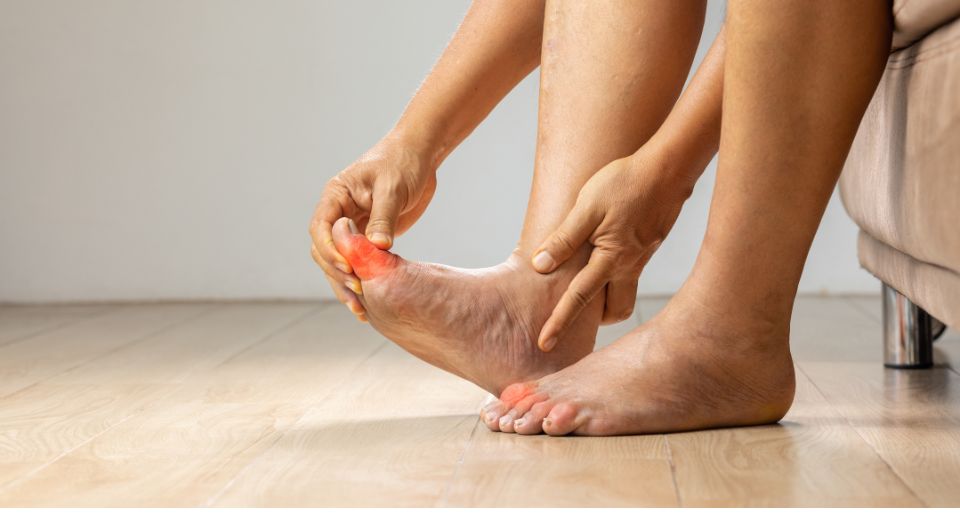Gout is a painful and potentially debilitating form of arthritis that has been recognized for centuries. Often referred to as the “disease of kings,” it is characterized by sudden and severe attacks of joint pain, most commonly affecting the big toe. This article will delve into the causes, signs, symptoms, diagnosis, risk factors, prevention, treatment options, and dietary triggers associated with gout. Understanding gout comprehensively is vital for managing and preventing this condition.
Causes of Gout
Gout is primarily caused by the buildup of uric acid in the body. Uric acid is a waste product formed when the body breaks down purines, substances found in certain foods and naturally occurring in the body. When uric acid levels become elevated, crystals can form in joints, tendons, and surrounding tissues, leading to the characteristic symptoms of gout.
Signs and Symptoms of Gout
Gout presents as acute, often excruciating pain, usually in the joint of the big toe, although it can affect other joints as well. Common signs and symptoms of gout include:
- Severe joint pain: Typically, gout pain strikes suddenly, often in the middle of the night, and can be described as throbbing, burning, or excruciating.
- Swelling and inflammation: The affected joint becomes red, swollen, and tender to the touch.
- Limited mobility: Due to the pain and inflammation, movement of the affected joint is restricted.
- Heat and redness: The skin around the affected joint may feel warm and appear red or purplish.
Diagnosis of Gout
To diagnose gout, healthcare professionals use a combination of clinical evaluation, laboratory tests, and imaging. They may:
- Examine the affected joint and assess your symptoms.
- Take a sample of fluid from the joint to check for the presence of uric acid crystals.
- Conduct blood tests to measure uric acid levels. It’s important to note that high uric acid levels alone may not necessarily indicate gout, as some people with gout have normal uric acid levels during an attack.
- Utilize imaging, such as X-rays or ultrasound, to visualize joint damage and the presence of uric acid crystals.
Risk Factors for Gout
Several factors increase the risk of developing gout, including:
- Gender: Men are more likely to develop gout than women, although women’s risk increases after menopause.
- Age: Gout is more common in individuals over 40.
- Family history: A family history of gout can increase the risk.
- Diet: Consuming foods high in purines, such as red meat, seafood, and alcohol, can elevate uric acid levels.
- Medical conditions: Certain conditions, like hypertension, obesity, and kidney disease, can increase the likelihood of gout.
- Medications: Some medications, like diuretics and low-dose aspirin, can contribute to higher uric acid levels.
Prevention of Gout
While some factors that contribute to gout are beyond an individual’s control, there are steps that can be taken to reduce the risk and prevent gout attacks. Key preventive measures include:
- Diet modification: Limit consumption of high-purine foods, such as red meat, organ meats, and seafood. Reducing alcohol and sugary beverage intake can also help.
- Weight management: Maintaining a healthy weight can decrease the risk of gout as obesity is a risk factor.
- Stay hydrated: Drinking plenty of water can help flush excess uric acid from the body.
- Medication: In some cases, medications may be prescribed to lower uric acid levels, particularly for individuals with recurrent gout attacks.
Treatment Options for Gout
Managing gout involves both treating acute attacks and preventing future ones. The following are common treatment options:
- Medications:
- Nonsteroidal anti-inflammatory drugs (NSAIDs) can reduce pain and inflammation during a gout attack.
- Colchicine is another anti-inflammatory medication used to relieve gout symptoms.
- Corticosteroids can be prescribed when NSAIDs or colchicine are not well-tolerated.
- Urate-lowering drugs like allopurinol and febuxostat are used to lower uric acid levels and prevent future gout attacks.
- Lifestyle changes:
- Resting the affected joint and elevating it can help reduce pain and swelling.
- Applying ice to the joint can also help with pain and inflammation.
- Avoiding trigger foods and maintaining a balanced, low-purine diet is crucial.
Foods that Trigger Gout
Diet plays a significant role in gout management. Certain foods can trigger gout attacks or exacerbate existing symptoms due to their purine content. While purine-rich foods should not be completely eliminated, moderation is key. Foods high in purines include:
- Red meat: Beef, lamb, and pork are particularly high in purines.
- Organ meats: Liver, kidney, and sweetbreads are very rich in purines.
- Seafood: Anchovies, sardines, mussels, and scallops have high purine levels.
- Alcohol: Beer, in particular, is associated with an increased risk of gout attacks.
- Sugary drinks: High fructose corn syrup in sugary beverages can contribute to higher uric acid levels.
In contrast, some foods may help prevent gout attacks or lower uric acid levels. These include:
- Low-fat dairy products: Milk, yogurt, and cheese may have a protective effect against gout.
- Cherries: Some studies suggest that cherries, especially tart cherries, may reduce the frequency of gout attacks.
- Vegetables: Consuming more vegetables, especially those low in purines, can be beneficial.
- Whole grains: Foods like brown rice, whole wheat bread, and oats can help maintain a balanced diet.
Gout is a painful form of arthritis that can have a profound impact on a person’s quality of life. Understanding its causes, symptoms, diagnosis, risk factors, prevention, treatment options, and dietary triggers is essential for effectively managing the condition. Gout can be managed through a combination of lifestyle changes, dietary modifications, and medication, allowing individuals to lead a more pain-free and fulfilling life. By maintaining a healthy diet and addressing underlying risk factors, gout sufferers can significantly reduce the frequency and severity of gout attacks, preventing long-term joint damage and discomfort.
Author: Sarah Chan, PA-C



